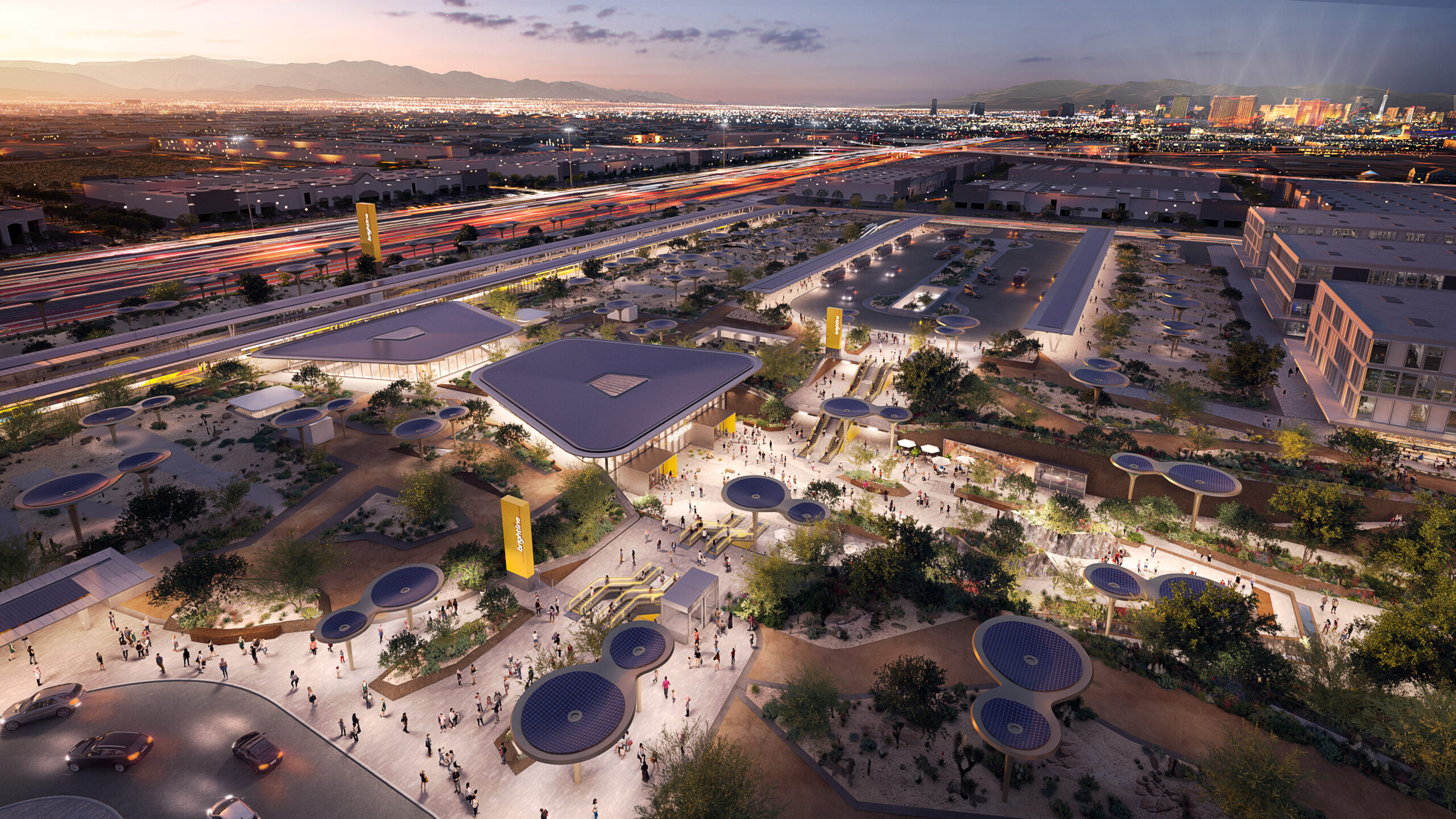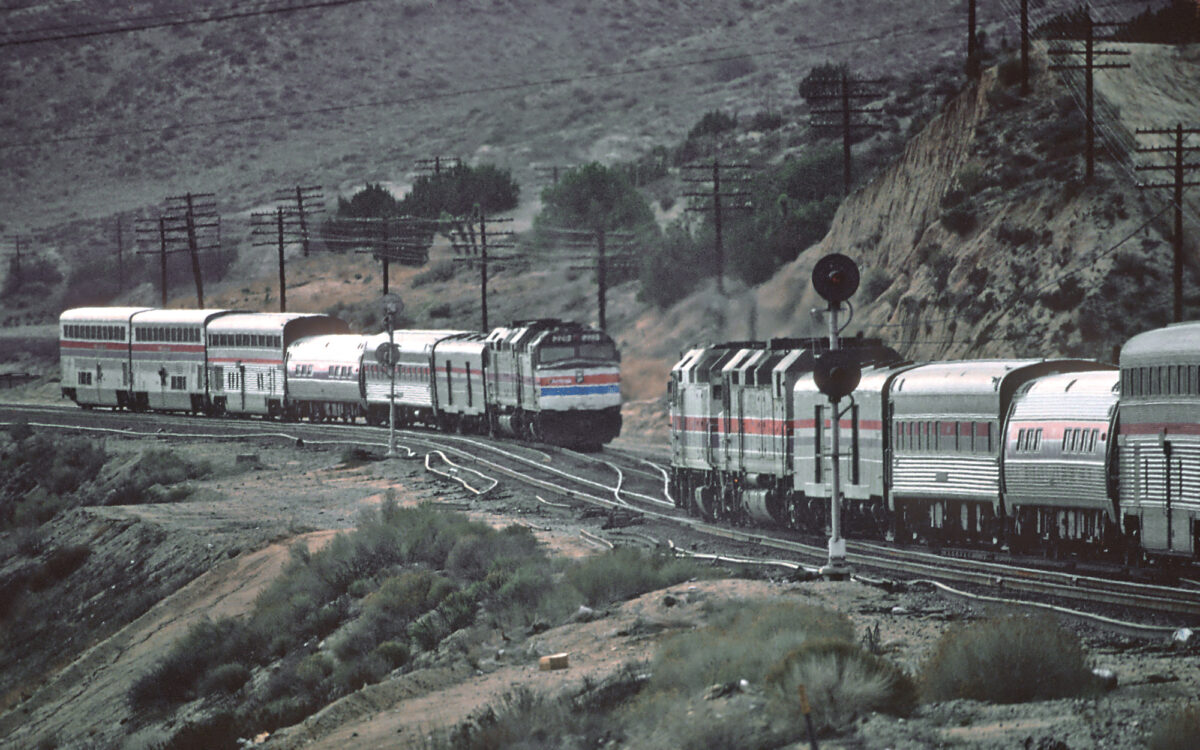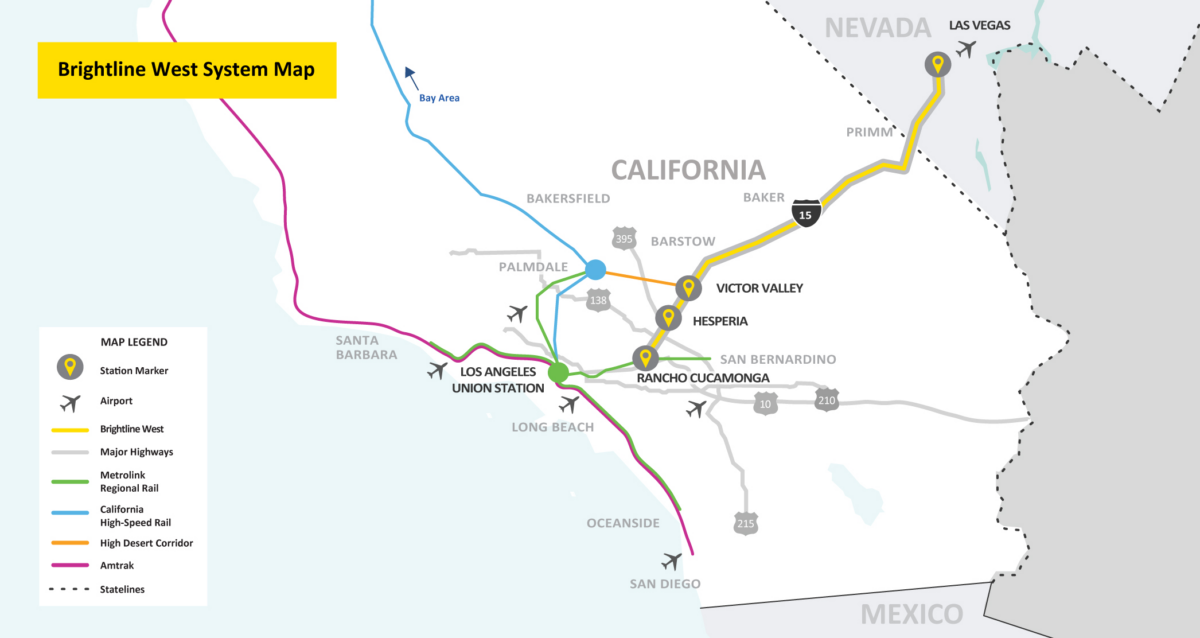Backers say Las Vegas high-speed rail finally on track after decades of disappointment

Almost every Sunday evening for the past two decades, thousands of tourists from Southern California have sat in their cars in a slow-moving, 17-mile traffic backup on I-15 on their way back from a Las Vegas weekend, and said to themselves, “There has to be a better way.”
At various points over that twenty-year period, a high-speed rail line has been proposed as a fix for the time it takes to travel between the two entertainment capitals. It’s a project that has both invigorated and frustrated developers and lawmakers — routes have been proposed and extended, environmental assessments completed and then made to sit stagnant, and federal funds have been promised and then never materialized — as multiple companies have tried to turn the transportation dream into an approved reality.
But now, after years of promises, a groundbreaking might happen.
The Nevada congressional delegation is backing an application from Brightline West and the Nevada Department of Transportation (NDOT) for $3.75 billion to build a high-speed rail line from outside of Los Angeles to Las Vegas, hoping the infusion of federal funds can get construction on the long-awaited project underway this year.
Successful completion of the proposed line would represent an end to nearly 20 years of developer and governmental interest. Work first began in 2005, but a combination of insufficient public funds, permitting holdups and congressional backlash kept construction from ever beginning, despite the support of public figures as powerful as former Senate Majority Leader Harry Reid (D-NV) and multiple generations of the Marnell family, leaders in casino development.
But Brightline, which already opened and operates the country’s only private intercity passenger railroad in South Florida, has brought the project closer to reality. The land and right-of-way acquisitions, construction readiness assessments and project-labor agreements are all in place. The environmental permitting process, where big infrastructure projects can get held up for years, is expected to conclude in July, with an initial positive outlook from the Federal Rail Administration.
Tina Quigley, the former CEO of the Regional Transportation Commission of Southern Nevada, has spent decades dreaming of and working toward a functioning rail line to ease traffic on the I-15 corridor, including a brief stint working for Virgin Trains USA in late 2019.
“What a total gift to those of us who care about capacity and infrastructure to have a private company that is doing all the heavy lifting to get this thing moving,” Quigley, now president and CEO of the Las Vegas Global Economic Alliance, said in an interview.
The last major piece needed in the transportation puzzle is funding — a major hurdle for the proposed line and other past projects, particularly given the lack of predictable, dedicated funding from the federal government, which has given rail the short shrift as administrations have prioritized highways, roads and airports in the post-World War Two period.
Even if the application is approved, the line is expected to be funded primarily through private investment, but the calculations somewhat shifted after passage of the 2021 Bipartisan Infrastructure Law, which authorized $36 billion in advance appropriations for the Federal-State Partnership for Intercity Passenger Rail program, with a portion of those funds carved out for projects outside of the Northeast Corridor, where most of the country’s rail operations are concentrated.
“Prior to the Bipartisan Infrastructure Law, money available for trains was peanuts — maybe a couple of peanuts, not even a handful,” said Rick Harnish, director of the High Speed Rail Alliance, a high-speed rail advocacy group. “As a result of the bill, there's now a bowl full.”
Brightline projects it will raise the requisite capital to begin construction this summer, with an ambitious three-and-a-half-to-four year construction timeline centered on a goal of beginning operations before the 2028 Summer Olympics in Los Angeles.
This year, more than $4.5 billion is available in grant funding for projects outside of the Northeast Corridor — the funding pot to which Brightline West is applying.
The project faces competition from California High Speed Rail (CHSR), the oft-delayed rail project intended to connect Los Angeles with San Francisco, though ballooning costs and the glacial pace of progress have made it a target of criticism and emblematic of the challenges facing the broader high-speed rail movement. CHSR is applying for $2.8 billion, forcing the federal government to choose between fully funding the rail projects.
In their letter to the Department of Transportation (DOT), Nevada’s six members of Congress and four California House members asked for expeditious funding of Brightline West’s application.
Michael Naft, a Clark County commissioner who has advocated for a train since his days as a district director for Rep. Dina Titus (D-NV), believes Brightline’s application is the most competitive one in the West. If approved, he said the grant would provide the final push needed to get shovels into the ground.
“This isn't something that's just kind of sketched on a piece of paper,” Naft said. “The design work is done, entitlements are done, the land use is done. They are largely ready to get people to work and move quickly toward helping solve a real transportation problem in a struggling corridor in the West.”
High-speed rail’s history
The idea for a bullet train between Southern California and Las Vegas had been kicked around since the 1980s, but it first gained serious traction in the mid-2000s after Amtrak shut down passenger service of its Desert Wind line serving both areas in 1997. Anthony Marnell II, the casino design magnate who founded the Rio, formed DesertXpress Enterprises in 2005, a company set up to explore building the line.
He began the basic design work for a proposed route starting in Victorville, a city in the San Bernardino Valley and a 90-minute drive from downtown Los Angeles, to Las Vegas. While developers wanted the line to connect to the Southern California Metrolink, permitting and construction between Victorville and further-west Palmdale proved expensive and full of hurdles.

The appeal was enormous to casino owners — providing California residents an alternate means of transportation to Las Vegas that is cheaper than flying and quicker than driving. Brightline estimates there are 50 million trips between the two cities each year, and that 85 percent are done by car — subjecting drivers to I-15 traffic that routinely backs up for miles on end. The high-speed line has long intrigued public officials in both states for its ability to spur economic activity, boost development along the stations, create thousands of construction jobs, and provide a climate-friendly alternative to air and car travel.
Reid, impressed by the proposal and its mostly private financing plan, backed Desert Xpress over other competing plans, including a proposed magnetic levitation train project that he previously supported but fell out of favor. Both Democratic and Republican governors explored and supported the idea through an appointed commission.
Desert Xpress estimated its budget to be $5 billion, expected to be almost entirely achieved through private investment, but received what seemed to be a potential new cash source when the Obama administration announced $8 billion in grant funding for high-speed rail projects through the 2009 stimulus bill.
But Marnell and Desert XPress quickly ran into a problem.
“The core challenge that he ran into was that we don’t make high-speed trains in the United States,” Harnish said.
The Obama administration wanted trains to be built in America — a supply chain and knowledge base that had dried up alongside the lack of federal rail funding over the past several decades. And lawmakers began raising concerns about the viability of a line beginning in Victorville, rather than Los Angeles, to bring in a sizable customer base.
Desert Xpress was also consistently dogged by a reputation of being a “gambler’s train” that would face difficulties in attracting the average traveler from Los Angeles, given the distance to its starting point from the city.
Still, Desert Xpress completed a final environmental impact statement — a critical permitting step — that was approved, along with the planned route, by the federal government in 2011. Company executives said they expected to break ground that year, contingent on a $6 billion loan from the FRA.
But the loan never came, amid the continued struggles to obtain materials produced in the U.S. In 2012, rebranded as Xpress West, developers applied for a different $5.5 billion loan. But the project was killed by then-Budget Chairman Rep. Paul Ryan (R-WI) and then-Senate Budget Ranking Member Jeff Sessions (R-AL), who recommended the DOT reject the application based on its cost and viability concerns, citing significant risk to taxpayers.
In 2013, then-DOT Secretary Ray LaHood confirmed the loan request had been suspended because of concerns over the ability to source materials in the U.S. instead of China. Despite interest from the Nevada Legislature and then-Gov. Brian Sandoval (including the creation of a state high-speed rail authority in 2015), the project appeared stalled. A 2015 effort to get funding from the Chinese government also failed.
But Brightline acquired the rights in 2019, breathing new life into the derailed line.
Brightline’s plan
Brightline is the first private company to develop an American passenger railroad in more than half a century. Its business model is to identify pairs of cities that are too close to one another to necessitate flying but too far to drive — typically 200 to 300 miles apart, a distance the company says has proven popular (and profitable) in Asia and Europe.
In South Florida, Brightline began operating a five-station line between Miami and West Palm Beach in 2018, with a planned extension to Orlando — the true moneymaker — expected to open this summer.
Brightline was created by billionaire investor Wes Edens, a co-owner of the Milwaukee Bucks, to bring a private version of the high-speed rail model seen across Asia to the United States. The company built its Florida system for $6 billion, and took in $32 million from 1.23 million passengers in 2022, a number expected to increase exponentially when the Orlando airport extension opens and riders can access Disney from South Florida, or fly into Orlando and immediately hop on the train to Miami and its suburbs. Edens, who called high-speed rail a “get-rich-very-slowly business” to Forbes, is also committed to running Brightline West with exclusively green energy, utilizing solar and geothermal power — potentially giving the company’s application an edge with the clean-energy-friendly Biden administration.
Brightline’s success in Florida is reassuring to skeptics of privately funded rail, or of trains in general. The company has pumped $600 million into the Nevada project thus far.
“This is so exciting to me because you have a project that has already provided proof of concept,” Naft said. “Brightline is a good operator; they're doing well. They're moving people efficiently.”
A company official said Brightline acquired Xpress West because of the existing 2011 environmental record of decision, but knew they needed to expand the line out from Victorville to Los Angeles to make the investment worth it. The company has spent the last three years updating the environmental permitting and expanding it to include a proposed extension to Rancho Cucamonga, a city 37 miles east of Los Angeles with an existing connection to Metrolink, Southern California’s commuter rail system.

Brightline has made a number of important steps toward actually starting construction, including acquiring the right-of-way through an agreement with NDOT and CalTrans to run the line down the median of I-15, a choice aimed at avoiding the endless civil litigation plaguing CHSR.
The company acquired land in Las Vegas in 2021, Apple Valley in 2020 and Rancho Cucamonga in 2022 where the future stations will go. The 110-acre plot in Las Vegas is on Las Vegas Boulevard, across from the Premium Outlets South mall on the southern end of the Strip. Naft, who represents the area on the County Commission, said he expects the station site would bring new development to the area. He added that its proximity to the Strip, Allegiant Stadium and Harry Reid International Airport — and particularly to the rental car facilities that crop up around it — could create “limitless” opportunities for multimodal transportation south of the Strip.
Brightline completed design and engineering readiness assessments, and has announced two memoranda of understating for project labor agreements. The first is for operations with 13 rail labor unions, announced in February, and the second, announced in March, is a deal with the Southern Nevada Building Trades Union and the State Building and Construction Trades Council of California to construct the line.
“Our thousands of high-skilled members of our allied unions are standing at the ready to build this rail system,” SNBTU executive secretary-treasurer Vince Saavedra said in a statement in the Las Vegas Review-Journal. “Nevada was built on the backs of our labor union members, and this historic rail project will continue that legacy.”
The final environmental permitting decision, submitted in November 2021 for the section between Victorville and Rancho Cucamonga, is expected this July. Brightine has already been through public comment for the Victorville-Rancho Cucamonga section, and is viewed favorably by the FRA, which said in its environmental assessment report that the proposed line would not have a significant adverse impact on the environment or low-income or minority populations.
Impacts
Brightline estimates the new line will create 35,000 construction jobs and 10,000 permanent jobs once the line is operational. It would be the nation’s first-ever high-speed rail line, with a maximum speed of up to 200 miles per hour and an estimated 85-minute journey.
Sen. Jacky Rosen (D-NV) has led the Nevada delegation’s work in advocating for Brightline’s application, sending a letter to the DOT last month in advance of Brightline’s submission singing the line’s praises.
A proponent of the state’s tourism industry, Rosen said she is most excited about the economic benefit the line would bring. Brightline projects the project will generate $10 billion in economic impact, and that it will serve 7 million passengers in its first year of operation, with the goal of stabilizing at around 11 million annual passengers, which would represent about 20 percent of trips between the two cities.
“It’s going to bring — over the course of years — billions of dollars in investments, jobs, more tourism,” Rosen said in an interview. “It’s great for the Nevada economy.”
Naft, who sits on the Las Vegas Convention and Visitors’ Authority board of directors, said I-15 traffic comes up at nearly every one of the marketing organization’s meetings. He said he worries about the economic consequences of absorbing the “PR hit weekend after weekend” when California visitors spend up to nine hours in traffic, making the train a promising alternative from a branding perspective.
Quigley added that making business travel between the two regions more seamless can help grow the nontourism sector of the city’s economy.
“The more we blur the lines between Southern California and Las Vegas, the easier it is to attract higher skill, higher wage type jobs to our region,” Quigley said. “We can diversify our economy.”
For Titus, a longtime rail advocate who served on the California-Nevada Super Speed Train Commission for more than a decade, the environmental benefits are a major draw. If Brightline hits its ridership goals, the company estimates that 3 million cars will be diverted from I-15, preventing up to 400,000 tons of carbon dioxide emissions each year.
As the only member of the Nevada delegation who was in Congress during the last moment of optimism for high-speed rail, Titus has seen how funds for high-speed rail can end up going nowhere. She voted for the stimulus package in 2009 that advocates hoped would deliver new lines, only to see the project fall apart.
The difference between then and now?
“[There’s] more money in there,” she said in an interview.
Next steps
The loan Brightline is applying for — $3.75 billion — would cover a significant portion of the estimated $10 billion the company needs for construction.
Harnish said public funding is critical because the capital required to build transportation projects or upgrades are rarely — if ever — possible or quickly recouped through revenue. Airports and highways are built by the federal government and operated by states or cities, and receive annual funding through dedicated taxes, in the case of highways, and formulas based on size and the political headwinds of the moment.
“To expect a railroad to build a new railroad totally privately is not reasonable,” Harnish said.
Brightline’s projected cost — even if it rises — is a fraction of the $128 billion CHSR has now budgeted, a number that has exponentially risen over the years. Titus said the cost difference, in addition to fading popularity for the line in California and challenges from municipalities opposed to the project, should give Brightline a competitive advantage at the DOT.
“[Ours] is a cleaner train in that it doesn’t have to go through so many jurisdictions,” Titus said. “Some of the environmental studies have already been done. It's a straight shot. So I think we can make a stronger argument.”
Quigley, who has seen every plan for a potential train start, sputter and eventually die out over the past decades, said she truly believes this train is on track. She remembers being an intern at the airport 30 years ago and reading newspaper clippings on the idea of a high-speed rail line coming to the region.
But between Brightline’s record, the land use and engineering work already done, and the commitment for federal funding, she feels certain this iteration is more than a desert mirage.
When she is finally able to ride the train, it will be a moment of immense pride and the realization of a career-long interest.
“How exciting is that?” Quigley said. “We're going to have the nation's very first true high-speed rail.”
